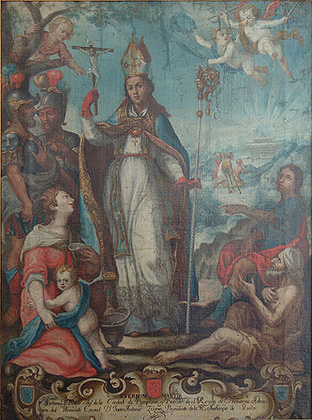Piece of the month of March 2006
AN UNPUBLISHED PAINTING OF SAN FERMÍN
Pilar Andueza Unanua
Chair of Navarrese Heritage and Art
The cult of San Fermín, co-patron saint of Navarre since 1657, spread throughout the Modern Age all over the world thanks to the religious fervour shown by numerous Navarrese who, having left their native kingdom, emigrated and settled mainly in Madrid, in the Indies and in commercial cities linked to the New World such as Cadiz and Seville. The greatest exponent of devotion to the former bishop of Pamplona came with the foundation in Madrid of the Royal Congregation of San Fermín de los Navarros, erected on 7 July 1683, under the reign of Charles II. For religious and charitable purposes, it brought together the natives of Navarre, first in the convent of the Mínimos de la Victoria and later in its own headquarters in the Prado de los Jerónimos, in a building acquired from the heirs of the Count of Monterrey. Both from Pamplona, where from 1696 a large chapel was erected in honour of the saint in the parish church of San Lorenzo, and from the aforementioned confraternity in Madrid, letters were sent to the countrymen living in the Indies in order to obtain financial resources to pay for the construction work for both enterprises. All these petitions were accompanied by engravings of the patron saint, thus making the engravings a vehicle of primary importance in the development of the devotions of the time. One of the most outstanding prints was commissioned by the Royal Congregation's board in 1732 from Juan Bernabé Palomino, who shortly afterwards became a chamber engraver and professor at the Royal Academy of San Fernando, who opened the plate following a drawing by the prominent Madrid treatise writer, painter and engraver Fray Matías de Irala y Yuso.

San Fermin
Quito School, third quarter of the XVIII century
Oil on canvas, 90,5 x ,5 cms.
Pamplona. Private collection
And it was precisely this engraving that served as model for the painting we are now analysing. Indeed, the importance achieved by this subject of prints is evident in this canvas, as it is a faithful copy of the copy engraved by Palomino, produced by an artist of the Quiteño school. Saint Fermín is depicted in a completely centred position, dressed in pontifical vestments, with crozier, mitre and pluvial cloak. He also holds a Crucifix in his right hand as a symbol of evangelisation, while at his feet is an acetre. This element, together with a woman prostrate at his feet, holding a veil and embracing a child, also symbolises Christianisation through baptism. In contrast to other images of the saint, it is also accompanied by a rich iconography consisting of the figures of a crippled man and a sick man on his right. The composition is completed by two Roman soldiers on the left and two angels on the upper right who bear the attributes of martyrdom. As is typical of the Baroque style, the invention of the saint's body is also included in the background, the sepulchre of which is highlighted by luminous rays that attract several sick people.
In this anonymous painting, from a good invoice, the bluish colours are predominant, contrasting with the red of certain items of clothing such as a tunic, a cloak, the saint's chirothecae and the soldiers' plumes.
The canvas was commissioned, according to the registration at the bottom, enclosed in a cartouche of clear eighteenth-century taste and accompanied by the emblems of Pamplona and Navarre - the artist made a mistake in applying the colour to the field of the coats of arms - by the Navarrese Juan Antonio Zelaya y Vergara. Born in the town of Miranda de Arga, he served the Bourbon monarchy in the army. He went to the Indies, specifically to the viceroyalty of the New Kingdom of Granada, where he held positions of high political and military responsibility. On 11 October 1763, Viceroy Pedro Messía de la Cerda appointed him military governor of Guayaquil, position , which he held until 1771. He made a complete report of that province, report , which he sent to the viceroy in 1765, giving him news of its geography as well as its population, clergy and commerce. His reputation as a military officer must have been well known, as he was called to Quito to put down the "uprising of the Barrios or Estancos", a riot that broke out on 7 May 1765 as a popular protest against the drastic administrative and economic reforms implemented by the authorities. Navarro, at the head of a battalion of 600 men recruited in Guayaquil, Panama and Lima, entered the city as captain general on 1 September 1766 and managed to subdue the uprising. From then until July of the following year, he served as interim president of his audience. Once the area had been pacified, he returned to Guayaquil where he remained in his government posts until 1771, when he was appointed governor of the province of Popayán (Colombia), whose capital he arrived on 2 October of that year.
As was usual with many of the Indianos from Navarre in the 18th century, Zelaya expressed his particular devotions through this canvas of San Fermín but also through the bequests he sent to his native town. As Father Janáriz recounts, this soldier sent several gifts to the patron saint of Miranda de Arga, the Virgin of the Castle, who, invoked by Zelaya, had saved him from an enemy shot. In gratitude for her protection, he sent several jewels to her basilica and commissioned a new carving in Seville, a candlestick image, which now presides over the main altarpiece, replacing the Romanesque image.
